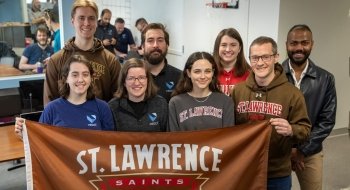
Investigating Educational Inequalities
Emily Casey-Wagemaker ’19 researched the policies that affect students attending high school in New York’s capital region.
While in high school, Emily Casey-Wagemaker ’19 took notice of numerous disparities between her own school and a neighboring one. Only two blocks from her high school in Niskayuna, New York, which is known for being well-resourced and having high-performing students, was another school known for being one of the most low-resourced and low-performing schools in the state.
“My perspective as a student from a lower socioeconomic standing than my peers made me think more critically about the dichotomy that was occurring within two blocks of each community’s schools,” Casey-Wagemaker explains. “I would ask myself, ‘Why is it that our school seemed to be overflowing with resources to advance students’ studies, while down the road, there was a school that barely graduated half its senior class?’”
Questions like these prompted Casey-Wagemaker to begin what would become a two-year -long research project, which investigated educational inequities in New York’s Capital District. A mathematics and Spanish double major with a minor in education, she received a Ronald E. McNair research scholarship for the summer after her sophomore year, teaming up with Associate Professor and Chair of the Department of Mathematics, Computer Science, and Statistics Daniel Look and Assistant Professor of Education Jessica Sierk.
During her first summer as a McNair Scholar, Casey-Wagemaker’s research was focused on a variety of outside factors that have contributed to the disparities that are seen in the U.S. education system, including the role of government, policy solutions, and zero-tolerance policies as well as assumptions and expectations of educators toward students.
After completing her initial project in 2017, she decided to continue her research. She received a second McNair scholarship for the summer after completing her junior year and furthered the research into her senior year. Her study now focuses on the disproportionality of discipline in the Capital District, which combines quantitative and qualitative analysis of the codes of conduct at 32 Albany-area schools.
“I found that race and socioeconomic status are both related to disciplinary action. Black students were more likely to be suspended and to drop out than their white peers. Furthermore, those students eligible for free or reduced lunch were also more likely to be suspended or drop out. These findings are consistent with the current literature,” Casey-Wagemaker says about her project. Her analysis looked at the overall sentiment of the Codes of Conduct, as well as picked out specific emotions (i.e. trust or fear) and the occurrence of those emotions across the texts among other indicators.
While conducting important research about the effects of race and class on educational opportunity, Casey-Wagemaker remained conscientious about her own positionality on the subject. “Growing up as a white woman in a wealthy, predominantly white, suburban town, with an extremely high-performing, high-resourced school, I did not face the same challenges that the students who I write about in my research do,” she says, but she also recognizes the complexity and nuanced differences of her own family’s lower-income status within an affluent school system.
Despite the time commitment and hard work that the project demanded, Casey-Wagemaker’s passion for educational equity for all kept her motivated to continue her research. “One of the reasons I started this research two years ago was because of the career path I have always dreamed about,” she says. “My first year here at St. Lawrence, I decided that I wanted to teach in an urban school district, and to do this, I decided that I wanted to become an expert in the school system in which I wanted to work. After I started my research, I realized that I was really passionate about policy reform.”
In April, Casey-Wagemaker presented her research at the American Educational Research Association (AERA) annual meeting in Toronto. She begins at New York University as a part of the Embedded Master of Arts in Teaching Residency in the fall, where she will be teaching math in the Syracuse City School District. Eventually, she would like to pursue a Ph.D. in education policy.
“My ultimate goal,” she says, “is to work in education policy and try to alleviate some of the adversity that minoritized students have to face.”




